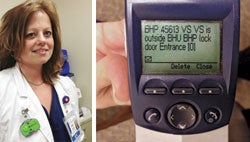Medical center's behavioral health unit extends RTLS
 |
|---|
| Photos courtesy of Western Maryland Regional Medical Center Left: Nurse manager Vicki Svensson wears a Versus badge, which features a call button to speed response time if a staff member is under duress. Right: An example of an alert sent to a staff member's phone when a patient is sensed close to an egress area. |
Medical center's behavioral health unit extends real-time locating system's reach
Western Maryland Regional Medical Center, Cumberland, was outfitted with real-time locating system (RTLS) technology when it opened in November 2009. But unlike many of its peers, the 275-bed facility went beyond using RTLS for such tasks as asset tracking.
The facility added RTLS capabilities to track patients in its 17-bed behavioral health unit to help prevent elopements and to manage patients who might try to access other patient rooms in the unit.
"We had a unique opportunity because we were building a new hospital, and we wanted to build a state-of-the-art facility that would accommodate patient needs using available technology," says Jeffery O'Neal, LCPC, systems director for the medical center's behavioral and occupational health services department.
He notes that RTLS has provided an extra layer of safety to patients and staff. Prior to having RTLS, the unit averaged 14 elopement attempts per year, O'Neal says, adding that these cases involved patients' leaving the unit but not the facility. In the ensuing four-plus years since RTLS implementation, there has not been a single elopement from the department.
Last April, the unit worked with Versus Technology Inc. — its RTLS vendor — to install staff-assistance software and badges equipped with call buttons linked to the RTLS system to provide greater safety and security to nurses and other staff in the behavioral health unit.
When a badge button is pressed, the Staff Assist software sends a pop-up alert showing both the staff member's name and location to workstations in the facility's call center, as well as to the nurses' station and Ascom wireless phones. The staff member's location is also highlighted on the Versus Enterprise View Mobile floor plan, which displays a map of the unit. Call center workers then call the code, knowing both the name and location of the staff member in crisis.
The technology has provided a vast improvement in response times, O'Neal says, with a four-minute average response time for staff assistance compared with 14 minutes before deploying the push-button badges. While these statistics highlight average times for the entire code response team to be deployed, in actuality, the response begins immediately once the button is pushed with other staff on the unit being notified and responding within seconds. Prior to having this RTLS capability, staff members used portable phones to call a code, which wasn't always possible if they were under duress.
"We're all trained to de-escalate situations, but just knowing you have that extra protection makes it a lot easier to press the button on the badge," says Vicki Svensson, R.N., nurse manager in the behavioral health unit.
More and more hospitals and health systems are exploring ways to add and expand their RTLS capabilities, says Barry Cobbley, director for sales engineering, Versus Technology. Perhaps the most promising and exciting aspect of RTLS, he notes, is the automation afforded through the convergence of context. "Some leading health care organizations are experiencing this by combining high-caliber locating data for patients, staff, assets and other items to significantly improve the delivery of care," Cobbley says.
Expanding RTLS capabilities can help organizations to know where patients have been, with whom they have come in contact, whether equipment used in their care has gone through proper cleaning and maintenance procedures, and share that context with users and other systems, Cobbley explains.
Other vendors see similar trends. Beth Young, R.N., CNN, director of marketing for Stanley Healthcare, says that beyond tracking patients, many hospitals are looking to RTLS to improve patient flow, monitor hand hygiene to improve infection prevention and reduce patient falls.




